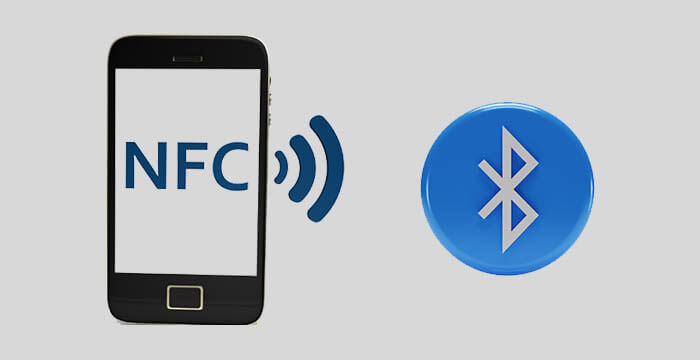NFC (Near Field Communication) is a technology that allows two devices to communicate with each other when they are close together, typically within 4 cm. NFC is used in numerous applications such as contactless payments, ticketing, and data exchange.
Bluetooth is a wireless technology standard that enables two devices to communicate over a short-range radio connection. Bluetooth is used in several applications such as hands-free headsets, wireless speakers, and file sharing.
These two technologies are often confused because they are both used for wireless communication. However, there are some key differences between NFC and Bluetooth that you should be aware of. Here’s a comprehensive guide:
What is NFC?
NFC (Near Field Communication) is a set of standards for mobile devices designed to enable them to communicate with each other by bringing them into proximity, usually no more than a few centimeters.
It is based on RFID (Radio-Frequency Identification) technology, which uses electromagnetic fields to communicate between devices. NFC devices can communicate with each other even if they are not paired or configured to do so.
NFC is used for several applications such as contactless payments, ticketing, and data exchange. NFC can also be used to initiate actions on devices, such as opening a webpage or downloading an app.
What is Bluetooth?
Bluetooth is one of the oldest and most popular wireless technologies. It was first developed in the late 1990s as a way to connect devices over short-range radio connections.
The technology requires that you pair two devices to establish a connection between them. Once paired, the devices can communicate with each other without the need for a physical connection.
It is regularly updated to improve compatibility and support new features. The latest version, Bluetooth 5.2, has advanced features such as mesh networking and direction finding.
What are the differences between NFC and Bluetooth?
While NFC and Bluetooth are both used for wireless communication, there are some differences between them, including:
- Operating Distance
This is one of the most important differences between NFC and Bluetooth. NFC devices are designed for near-range communication and can achieve a maximum distance of 4 cm. This is only enough for two devices to touch or be close.
In contrast, Bluetooth has a much longer range and can achieve distances of up to 10 m. This makes it ideal for use in larger spaces such as a room or a car. Additionally, Bluetooth devices can be paired without the need for a physical connection, which is not possible with NFC.
However, Bluetooth’s long range comes at the expense of power consumption. NFC devices are low-power and can operate for extended periods on a single battery. On the other hand, Bluetooth uses more power and will need to be recharged more frequently.
- Operating Frequency
NFC operates at a frequency of 13.56 MHz, the same frequency as HF RFID tags. On the other hand, Bluetooth operates at 2.4 GHz, which is the same frequency as most Wi-Fi connections.
The difference in operating frequencies means you cannot use NFC and Bluetooth together. NFC devices can only communicate with other NFC devices, and Bluetooth devices can only communicate with other Bluetooth devices.
- Security
NFC is more secure than Bluetooth because it uses a shorter range and requires physical contact between devices. This makes it more difficult for NFC signals to be intercepted and makes it less likely for unauthorized devices to access your data.
Additionally, NFC supports encryption and requires authentication before allowing two devices to communicate. This adds an extra layer of security to prevent data breaches.
Bluetooth’s PIN-based authentication can be bypassed, making it less secure than NFC. However, the latest version of Bluetooth includes advanced security features such as LE Privacy and Secure Connections that make it more secure.
Overall, NFC is ideal for crowded & busy areas like markets, metros, and exhibition halls where the chances of data interception are higher. On the other hand, you should avoid using Bluetooth in these situations as it is easier for someone to intercept your data.
- Data Transfer Rate
The data transfer rate of NFC is lower than that of Bluetooth. NFC has a maximum data transfer rate of 424 kbps, while Bluetooth can achieve speeds of up to 2 Mbps.
This difference in data transfer rate is due to the diverse ways that NFC and Bluetooth transmit data. NFC uses a simple binary protocol designed for small amounts of data, such as credit card information.
In contrast, Bluetooth uses a more sophisticated protocol optimized for larger amounts of data. This makes Bluetooth better suited for tasks such as streaming audio or transferring files.
- Connection Speed
Another difference between NFC and Bluetooth is the speed at which they can establish a connection. NFC can establish a connection almost instantly, while Bluetooth takes a few seconds to connect.
This difference is due to the way that NFC and Bluetooth work. NFC uses simple commands that are easy to process, which allows two devices to connect quickly. Bluetooth, on the other hand, uses a more complex protocol that requires more time to process.
The rapid NFC connection speed is useful for tasks such as making a payment or sharing small amounts of data. Bluetooth’s slower connection speed is not a major issue for most tasks, such as streaming audio or transferring files.
- Supported Devices
NFC is supported by most modern smartphones, including Android, iPhone, and Windows Phone devices. NFC tags can also be found in some smart watches, fitness trackers, and other wearable devices.
Bluetooth is also supported by most modern smartphones and has a much wider range of compatible devices. Bluetooth headsets, keyboards, mice, and speakers are all common devices that use Bluetooth to connect wirelessly.
- Power Consumption
NFC is your ultimate technology if you are looking for low power consumption as it only requires power when two devices are nearby. You can keep the NFC option ON without worrying about the battery drainage.
On the other hand, Bluetooth is a power-hungry technology and keeps on searching for new devices even when you are not using it. This leads to significant battery drainage, and you might have to charge your smartphone more often.
If you are not using Bluetooth for an extended period, it is better to turn it OFF to save battery life. Otherwise, it will keep on searching for devices and will consume a lot of power in the process.
NFC vs. Bluetooth – Differences in Functions
NFC Functions
NFC has the following three primary functions:
- Smart Posters. These are NFC tags readable by NFC-enabled devices, including phones. They can contain information such as text, URLs, or phone numbers.
- INTENT Filters. INTENT filters allow Android apps to register themselves as handlers for specific types of NFC tags. For example, an app could register itself as a handler for URL-type NFC tags.
- Card Emulation. Card emulation allows NFC-enabled devices to behave like credit cards or other smart cards. This allows you to use your smartphone to make payments at retail stores or on public transportation.
Bluetooth Functions
Bluetooth has the following three primary functions:
- Wireless Audio. You can use Bluetooth to wirelessly stream audio from one device to another. This is useful for listening to music or making hands-free phone calls.
- Wireless Data Transfer. You can use Bluetooth to transfer data wirelessly between devices. This is useful for tasks such as sharing files or syncing devices.
- Wireless Connectivity. Bluetooth is ideal for connecting devices wirelessly. This is useful for connecting keyboards, mice, and other accessories to your smartphone.
NFC vs. Bluetooth- Which One Should You Use?
The choice of NFC or Bluetooth depends on your needs:
- What Do You Want to Achieve? This is the most important question to ask. If you want to share data or connect accessories, Bluetooth is a better choice. If you want to make payments or interact with smart posters, NFC is a better choice.
- What Devices Do You Have? Another important consideration is compatibility. If you have an iPhone, you can only use NFC for Apple Pay. If you have an Android device, you can use NFC for a wider range of tasks.
- Do You Need Low Power Consumption? If you need to save battery life, NFC is the better choice as it only consumes power when two devices are near each other.
- What is Your Target Read Range? If you need a longer read range, Bluetooth is the better choice. NFC has a maximum read range of about four inches, while Bluetooth has a maximum read range of about 3 feet. This means that you can use Bluetooth with cooking appliances, radios, and other devices that are further away.
In general, NFC is better for tasks that require high security or low power consumption. Bluetooth is better for tasks that require a longer read range or compatibility with a wider range of devices.


